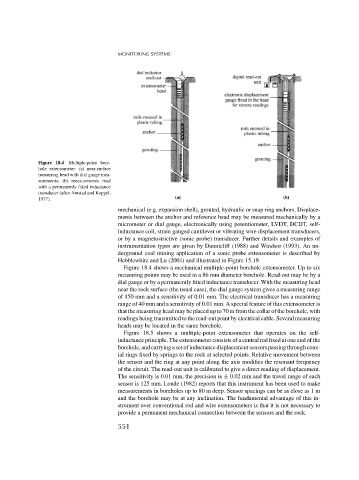Page 569 - Rock Mechanics For Underground Mining
P. 569
MONITORING SYSTEMS
Figure 18.4 Multiple-point bore-
hole extensometer: (a) near-surface
measuring head with dial gauge mea-
surements; (b) measurements read
with a permanently fitted inductance
transducer (after Amstad and Koppel,
1977).
mechanical (e.g. expansion shell), grouted, hydraulic or snap ring anchors. Displace-
ments between the anchor and reference head may be measured mechanically by a
micrometer or dial gauge, electronically using potentiometer, LVDT, DCDT, self-
inductance coil, strain gauged cantilever or vibrating wire displacement transducers,
or by a magnetostrictive (sonic probe) transducer. Further details and examples of
instrumentation types are given by Dunnicliff (1988) and Windsor (1993). An un-
derground coal mining application of a sonic probe extensometer is described by
Hebblewhite and Lu (2004) and illustrated in Figure 15.19.
Figure 18.4 shows a mechanical multiple-point borehole extensometer. Up to six
measuring points may be used in a 86 mm diameter borehole. Read-out may be by a
dial gauge or by a permanently fitted inductance transducer. With the measuring head
near the rock surface (the usual case), the dial gauge system gives a measuring range
of 150 mm and a sensitivity of 0.01 mm. The electrical transducer has a measuring
range of 40 mm and a sensitivity of 0.01 mm. A special feature of this extensometer is
that the measuring head may be placed up to 70 m from the collar of the borehole, with
readings being transmitted to the read-out point by electrical cable. Several measuring
heads may be located in the same borehole.
Figure 18.5 shows a multiple-point extensometer that operates on the self-
inductance principle. The extensometer consists of a central rod fixed at one end of the
borehole, and carrying a set of inductance displacement sensors passing through coax-
ial rings fixed by springs to the rock at selected points. Relative movement between
the sensor and the ring at any point along the axis modifies the resonant frequency
of the circuit. The read-out unit is calibrated to give a direct reading of displacement.
The sensitivity is 0.01 mm, the precision is ± 0.02 mm and the travel range of each
sensor is 125 mm. Londe (1982) reports that this instrument has been used to make
measurements in boreholes up to 80 m deep. Sensor spacings can be as close as 1 m
and the borehole may be at any inclination. The fundamental advantage of this in-
strument over conventional rod and wire extensometers is that it is not necessary to
provide a permanent mechanical connection between the sensors and the rock.
551

